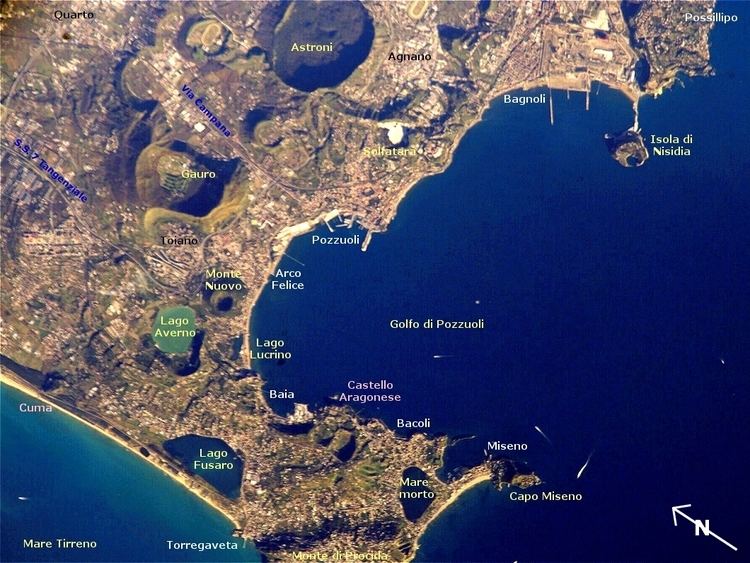Last eruption 1538 | Age of rock 40,000 years Elevation 458 m | |
 | ||
Similar | ||
The Phlegraean Fields (Italian: Campi Flegrei [ˈkampi fleˈɡrɛi]; Neapolitan: Campe Flegree, from Greek φλέγω phlego, "to burn") are a large volcanic area situated to the west of Naples, Italy. It was declared a regional park in 2003. Lying mostly underwater, the area of the caldera consists of 24 craters and volcanic edifices. Hydrothermal activity can be observed at Lucrino, Agnano and the town of Pozzuoli. There are also effusive gaseous manifestations in the Solfatara crater, the mythological home of the Roman god of fire, Vulcan. This area is monitored by the Vesuvius Observatory.
Contents
- Map of Phlegraean Fields 80078 Pozzuoli Naples Italy
- Geological phasesEdit
- More recent historyEdit
- WineEdit
- Cultural importanceEdit
- References
Map of Phlegraean Fields, 80078 Pozzuoli, Naples, Italy
The area also features bradyseismic phenomena, which are most evident at the Macellum of Pozzuoli (misidentified as a temple of Serapis), as geologists puzzled over bands of boreholes left by marine molluscs on marble columns, showing that the level of the site in relation to sea level had varied.
Geological phasesEdit
Three geological phases or periods are recognised and distinguished.
More recent historyEdit
The caldera, which now is essentially at ground level, is accessible on foot. It contains many fumaroles, from which steam can be seen issuing, and over 150 pools of boiling mud at last count. Several subsidiary cones and tuff craters lie within the caldera. One of these craters is filled by Lake Avernus.
In 1538, an eight-day eruption in the area deposited enough material to create a new hill, Monte Nuovo. It has risen about 2 metres (7 ft) from ground level since 1970. It is a volcano capable of producing VEI 7 eruptions, as large as that of Tambora in 1815.
At present, the Phlegraean Fields area comprises the Naples districts of Agnano and Fuorigrotta, the area of Pozzuoli, Bacoli, Monte di Procida, Quarto, the Phlegrean Islands (Ischia, Procida and Vivara).
A 2009 journal article stated that inflation of the caldera centre in the vicinity of Pozzuoli might presage an eruptive event within decades. In 2012 the International Continental Scientific Drilling Program planned to drill 3.5 km (2.2 miles) below the earth's surface near Pompeii intending to monitor the massive molten rock chamber below in order to provide early warning of any eruption. Local scientists are worried that such drilling itself could initiate an eruption or earthquake. In 2010 the Naples city council had prevented the drilling project. Programme scientists said the drilling was no different from industrial drilling in the area. The newly elected mayor allowed the project to go forward. A Reuters article emphasized that the area could produce a "super volcano" that might kill millions.
A recent study from Istituto Nazionale di Geofisica e Vulcanologia describing recent volcanic unrest of Campi Flegrei caldera from January 2012 to June 2013 characterised by rapid ground uplift of about 11 centimetres (4 in) with a peak rate of about 3 centimetres (1 in) per month during December 2012 mentions, that in previous years from 1985 to 2011 dynamics of ground uplift has been mostly linked to caldera's hydrothermal system. As study describes, this relation broke down in 2012 and the driving mechanism of the ground uplift changed to periodical emplacement of a magma within a flat, sill-shaped magmatic reservoir in depth cca 3,000 metres (9,843 ft), 500 metres (1,640 ft) south from port of Pozzuoli
In December of 2016, activity became so high that an eruption was feared.
WineEdit
Italian wine, both red and white, under the Campi Flegrei DOC appellation comes from this area. Grapes destined for DOC production must be harvested up to a maximum yield of 12 tonnes/hectare for red grape varieties, and 13 tonnes/ha for white grape varieties. The finished wines need to be fermented to a minimum alcohol level of 11.5% for reds and 10.5% for whites. While most Campi Flegrei wines are blends, varietal wines can be made from individual varieties, provided the variety used comprises at least 90% of the blend and the wine is fermented to at least 12% alcohol for reds and 11% for whites.
Red Campi Flegrei is a blend of 50-70% Piedirosso, 10-30% Aglianico and/or Sciascinoso and up to 10% of other local (both red and white) grape varieties. The whites are composed of 50-70% Falanghina, 10-30% Biancolella and/or Coda di Volpe, with up to 30% of other local white grape varieties.
Cultural importanceEdit
Campi Flegrei has had strategic and cultural importance.
